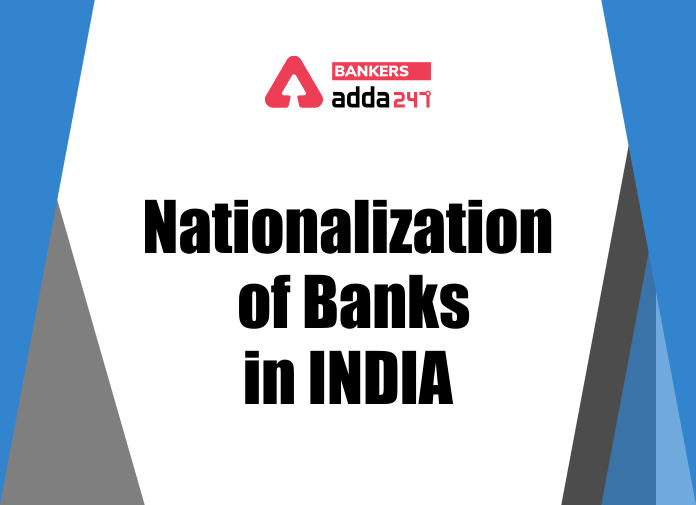Nationalization refers to an act when an entity or organization is transferred to the public sector which was earlier a private sector entity. In other words we can also understand it as that when the government increases its share in an entity is known as nationalization. Opposite of Nationalization is privatization. It is one of the most important topic from exam point of view and today in this article, we will be discussing every aspect of it to give you in-depth knowledge of this.
Need And Objectives Of Nationalization
It was immediately after independence that the government realized and decided to adopt planned economy and thus it was in 1951 that India embarked on a socialist path with first five year plan. One of the basic building block of planned / socialist economy is social ownership of means of production. Further, it is important for the government that it had some social welfare schemes and needed banking sector support to fulfill those. Also, there was a monopoly in banking sector over banking, the confidence of the people on banks was very low and this was a big hurdle in expansion of the banking in India. Thus, nationalization was seen as a remedy of many malaises. This includes the following:
- With the help of nationalization, Banks under government would support the government to achieve its social welfare objectives by directing funds to needy sectors of economy.
- Monopoly of the private banks could be ended with the help of nationalization.
- Nationalization will help the Banking to expand into all parts of country because of people’s inherent confidence in government. The banking sector helps to improve the confidence level of the public because in those days, most banks were not trusted by the majority of the people. Instead, the deposits with the Postal department were considered rather safe.
- Taking banks to villages could help bridge the rural-urban divide and can help in the financial inclusion.
- With nationalization, agriculture and allies activities could be given more timely funds.
First Nationalization Of Bank of India
It was Imperial Bank of India which was first Nationalization was first introduced in India nationalized bank of India, which was nationalized and later on renamed as State Bank of India (SBI) in July 1955 through SBI Act. State Bank of India was given the responsibility of the principal agent of RBI and it handled all banking transactions of the Union and State Governments. Further, in a major process of nationalization, seven subsidiaries of the State Bank of India were nationalized via the State Bank of India (Subsidiary Banks) Act, 1959.
14 Banks Were Nationalized In 1969
It was in 1969, fourteen major private commercial banks were nationalized. These 14 banks Nationalized in 1969 are as follows:
- Central Bank of India
- Bank of Maharashtra
- Dena Bank
- Punjab National Bank
- Syndicate Bank
- Canara Bank
- Indian Bank
- Indian Overseas Bank
- Bank of Baroda
- Union Bank
- Allahabad Bank
- United Bank of India
- UCO Bank
- Bank of India
| Banking Awareness: Different Types of Banking | Banking Awareness: What Are NBFC And Their Functions | Bank Cheques: Different Types of Cheques and its features |
Second Process Of Nationalization In 1980
In 1980, the second major phase of nationalization occurred, when Government of India acquired the ownership of 6 more private banks and acquired them, thus bringing the total number of Nationalized Banks to 20. These 6 banks were:
- Punjab and Sind Bank
- Vijaya Bank
- Oriental Bank of India
- Corporate Bank
- Andhra Bank
- New Bank of India
This entire process of nationalization resulted in 20 nationalized banks in India by 1980. Out of the given above six, New Bank of India was later on merged into Punjab National Bank in 1993 and this left 19 nationalized banks in India at that time.
Also Read,
| Banking Awareness: What Is Ways & Means Advances? | Banking Awareness- What is a Debenture? | Banking Awareness: Credit Rating Agencies in India |
Result of nationalization of Banks
Around 80% of the banking sector came under the public sector / government ownership, After the two major phases of nationalization. It was after the nationalization of banks, the branches of the public sector banks in India rose to approximately 800 percent in deposits, and advances took a huge jump by 11,000 percen which was a great boost for the economy. Government ownership gave the public implicit faith and immense confidence in the sustainability of public sector banks.



 GA Capsule for SBI Clerk Mains 2025, Dow...
GA Capsule for SBI Clerk Mains 2025, Dow...
 The Hindu Review October 2022: Download ...
The Hindu Review October 2022: Download ...
 SBI PO Cut Off 2025, Check Category Wise...
SBI PO Cut Off 2025, Check Category Wise...


